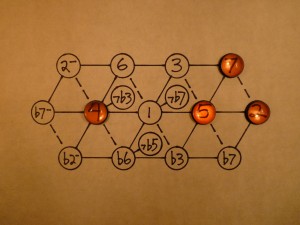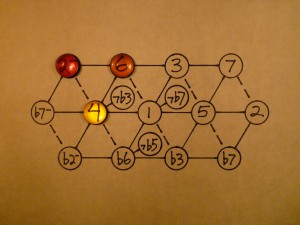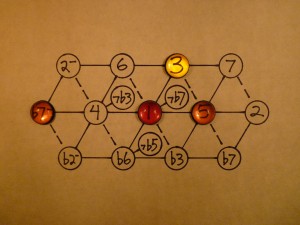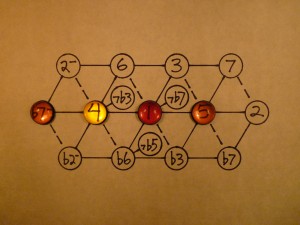To the Far Northwest
The chorus of Be Love is solidly in major territory. The chords are I, V, IV, the classic backbone chords of the major scale.
The verse, however, is going to be back in the Northwest — I, bVII-, IV. I have to get back over there somehow, and I want to lead the ear strongly so that the move feels right.
Once again I’ll use a dominant seventh type chord. Here’s the shape again:
The ear expects a I chord to come after this. Perhaps it’s one of those “nature abhors a vacuum” things. All the notes have tonal gravity that is pointing at the center, yet there’s nothing there. It’s as though the planets are orbiting the sun, and the sun is missing. The ear wants to put it there.
This “dominant seventh” shape is named after the dominant chord, the V7, where it shows up so often. It can be used elsewhere, and is the main tool used in classical music to change keys.
When I started to work this out, I already had a climax in mind for the chorus. In the last line, I wanted to leap all the way to the far Northwest, the ii- chord (lower case roman numerals mean it’s a minor chord), and have the melody sit still while the chords revolve around it. Here’s the ii-:
It’s a long leap, but I can make it with one transition chord, the I7.
Adding a seventh to the I chord sends a strong signal to the ear: “We’re going west!” Normally the next chord would be a IV.
This move is used all the time in music. It’s common for the bridge of a song to start on a IV chord — it’s a shift on the lattice that makes the bridge sound different from the rest of the music, much like my shift to major for the chorus of Be Love. Putting a I7 right before the bridge tells the ear to expect this shift.
I do something a little different, though. There is also a huge vacuum where the ii- ought to be — look how the two chord shapes fit into each other. Sure enough, going to the ii- after the I7 is satisfying and dramatic. Here’s how the sequence looks and sounds.
Notice how the melody leads the way again, by going to the 4. There’s another lovely passing chord, a stack of perfect fifths, right before the change.
Next: The Septimal Minor Third



